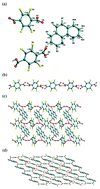A cooperation molecular recognition study: syntheses and analysis of supramolecular assemblies of tetrafluoroterephthalic acid with some aza compounds†
Abstract
A series of new molecular complexes, both co-crystals and salts, constructed by

* Corresponding authors
a
College of Chemistry and Molecular Engineering, Qingdao University of Science and Technology, Qingdao 266042, P. R. China
E-mail:
inorchemwl@126.com
Fax: +86 532-840-22681
A series of new molecular complexes, both co-crystals and salts, constructed by

 Please wait while we load your content...
Something went wrong. Try again?
Please wait while we load your content...
Something went wrong. Try again?
L. Wang, L. Zhao, Y. Hu, W. Wang, R. Chen and Y. Yang, CrystEngComm, 2013, 15, 2835 DOI: 10.1039/C3CE26865A
To request permission to reproduce material from this article, please go to the Copyright Clearance Center request page.
If you are an author contributing to an RSC publication, you do not need to request permission provided correct acknowledgement is given.
If you are the author of this article, you do not need to request permission to reproduce figures and diagrams provided correct acknowledgement is given. If you want to reproduce the whole article in a third-party publication (excluding your thesis/dissertation for which permission is not required) please go to the Copyright Clearance Center request page.
Read more about how to correctly acknowledge RSC content.
 Fetching data from CrossRef.
Fetching data from CrossRef.
This may take some time to load.
Loading related content
